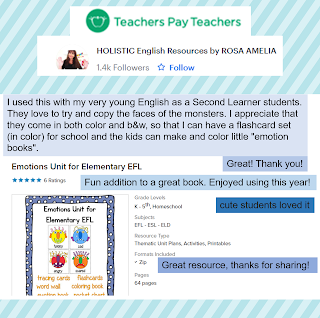More resources for Halloween !! Here´s the link:
https://www.teacherspayteachers.com/Product/31-days-of-Halloween-for-Kindergarten-and-Elementary-ESL-6087756
Label the cards. Review face and body vocabulary besides the clothes of these Halloween
children. I made two size labels. Laminate or place each one into a plastic sheet and they can write all the words instead of gluing.
I see Coloring
Book. Some teachers see coloring as a
waste of time but it has many advantages. It improves the student´s
handwriting. They can learn how to be patient, to focus on their work, to concentrate.
It stimulates creativity and self- expression.
Candy Corn Color
Words. Just a simple worksheet that children color as indicated.
Then have
them cut all the candy corns.
Say a new way to put a candy corn together.
Teacher: pink,
white, orange.
This is a good listening activity. But turn it into speaking as a
student says another option and the class builds the candy corn as said. They
can do this in small group and paste it onto cardboard for decoration.
A set of Flashcards to
introduce and assist in learning the Halloween words. Just print them. I made
them small so it is easy to carry from one class to another.
Make a grid on the board, on one side the letter and on the other the
number.
Say a letter and number combination:
Teacher: D4
Students: bag !
Use the template and make bottle caps letters to write the Halloween
words.
I made a Haunted House! I
glued it onto a shoe box and all the characters I placed them on the biggest clip
I found.
This is the teacher´s version for reviewing prepositions.
Place the characters and say a sentence.
Teacher: The
cat is behind the house. Continue with the other Halloween children.
Then ask questions:
Teacher: Where
is the ghost ?
Students: He
is in front of the house.
Hand in the student´s version. Have them make a poster by putting up
their own version of the Haunted House. They will have to write some sentences
and present it to the class. It can be done individually or in groups.
The Pocket chart ! They work
as visuals for students to make connections in reading. They can associate
sentences to pictures by themselves or in small groups.
A
nice memory game. But I also made a witch that can be fed with the Halloween
words. I glued her onto the tap of the shoe box that I used for the Haunted
House.
Play the
concentration card game using Halloween flashcards, or the old game Go Fish:
I usually print 4 copies of the cards and paste them onto black
construction paper. In groups of 4, students sit in a circle and
take turning asking each other a question. Do you have (a
ghost)? If the answer is YES, the student hands in the card and
the students that asked makes a pair and put it away on his/her pile. If the
answer is NO, the student doesn´t get a card and the turn is for another
student in the circle. The winner is the student that makes more pairs.
Another book with the Halloween
characters on cars.
I added puppets to make a running race with the puppets and assign first, second place to review the ordinal numbers.
The Matching cards are fun to play.
I got the idea to make colored plates because buying a set
of plates in each color is too much money. I got small paper plates and colored
the inner circle in each. Then it is just sort the cards in each plate.
And just pairing all the cards is a good reading activity.
Play Bingo with the cards! Hand in a Spinner to each student and have them write any color and Halloween noun combination and play the Bingo game.

























































